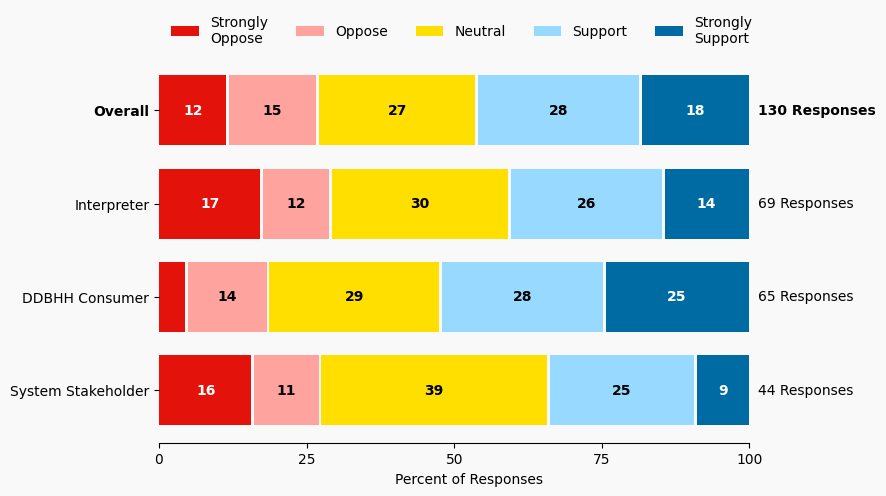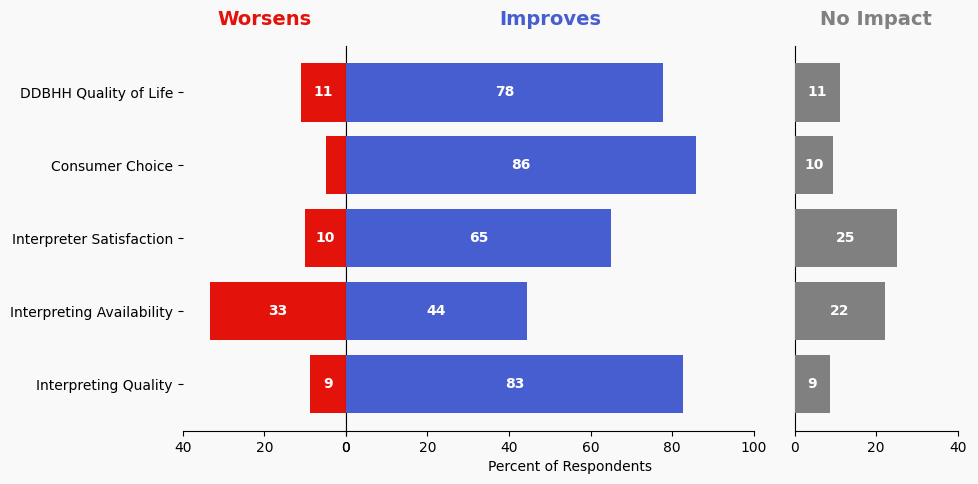18 Establish Licensure for Interpreters
Issue: Concerns about interpreter quality or other complaints are not being resolved via the current mechanisms of RID or interpreter referral companies..
Proposed Solution: Coalition or Task Force could research effectiveness of licensing in other states and the will of DDBHH and interpreting communities to establish licensure in Minnesota. If licensure is desirable, the coalition will develop a licensing proposal for legislation.
Expected outcome: Interpreters would have clear requirements due to legislation. Consumers would have another venue for complaints to be addressed.
Who is impacted: Interpreters, consumers
Timeline: 6 months

Summary of Support Image Description
The stacked bar charts show how respondents rated their level of support and the total number of responses. The percentage for the five support levels is shown from left to right: Strongly Oppose (Dark Red), Oppose (Light Red), Neutral (Yellow), Support (Light Blue), and Strongly Support (Dark Blue).
Respondents may identify with multiple subgroups. The overall level of support is:
Overall
Strongly Oppose: 12%
Oppose: 15%
Neutral: 27%
Support: 28%
Strongly Support: 18%
Click to see the detailed image description for each subgroup.
Interpreter
Strongly Oppose: 17%
Oppose: 12%
Neutral: 30%
Support: 26%
Strongly Support: 14%
DDBHH Consumer
Strongly Oppose: 5%
Oppose: 14%
Neutral: 28%
Support: 28%
Strongly Support: 25%
System Stakeholder
Strongly Oppose: 16%
Oppose: 11%
Neutral: 39%
Support: 25%
Strongly Support: 9%
Overview of Respondents Opting for In-Depth Solution Analysis
After indicating their support level, 13% of the 130 respondents opted in to further assess whether the solution would worsen or improve on five metrics. Of the opt-in reviewers (18 respondents), 44% supported the solution, 16% were neutral on the solution, and 38% opposed the solution.
The remaining 112 respondents did not opt in to further assess the solution. Of these people, 46% support the solution, 28% were neutral on the solution, and 25% opposed the solution.
Reviewer Evaluation of Solution Effectiveness

Solution Effectiveness Image Description
The stacked bar charts show how respondents assessed the effectiveness of this solution based on five metrics. For each metric, the percentage of respondents is shown from left to right: Worsens (Red), Improves (Blue), No Impact (Gray).
DDBHH Quality of Life
Makes It Worse 11%
Makes It Better 77%
No Impact 11%
Interpreter Satisfaction
Makes It Worse 10%
Makes It Better 65%
No Impact 25%
Consumer Choice
Makes It Worse 4%
Makes It Better 85%
No Impact 9%
Interpreting Availability
Makes It Worse 33%
Makes It Better 44%
No Impact 22%
Interpreting Quality
Makes It Worse 8%
Makes It Better 82%
No Impact 8%
Reviewer Feedback and Insights
Interpreter
Comments from Interpreters expressed broad support for licensure in the field of educational interpreting, citing the increased pay as an incentive to increase interpreter availability. Concerns were expressed that in non-education interpreting, the complexity or lack of infrastructure support may result in lack of enforcement and reduce availability in community-based interpreting.
Deaf, DeafBlind, Hard of Hearing
Comments from respondents identifying as DDBHH expressed support for a grievance and accountability system, and that pursuing targeted and iterative solutions to specific concerns may be more cost effective than implementing state-wide licensure.
System Stakeholder
Comments from System stakeholders expressed concerns that cost and complexity of maintaining licensure would disproportionately impact interpreters from marginalized communities, and that a 4 year degree requirement may shut out interpreters that enter the field through interpreting training programs following a 2-year degree.
PREVIOUS SOLUTION
Issue: Concerns have been raised about interpreters’ pay and benefits.
NEXT SOLUTION
19 Centralize Referral System under Minnesota Commission
Issue: All current interpreter referral companies are private, for-profit entities.
Leave a Reply